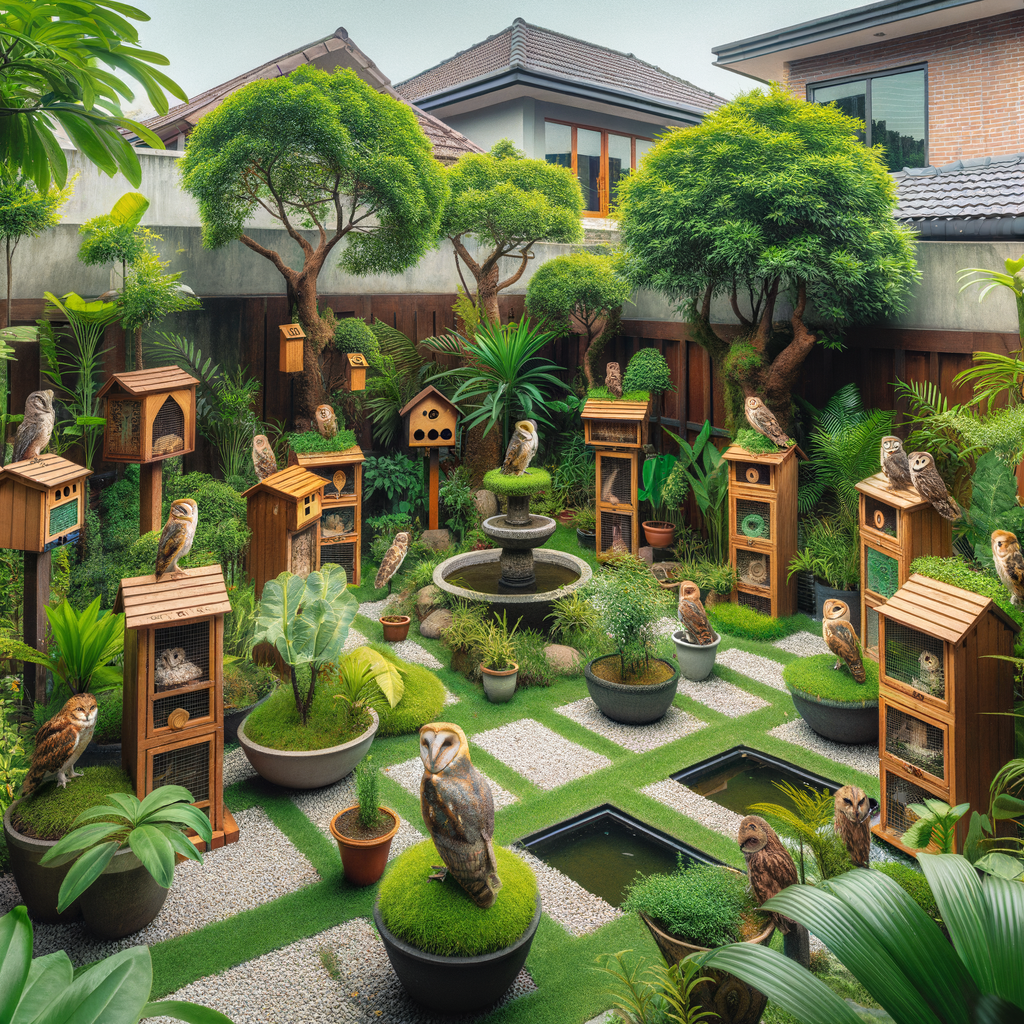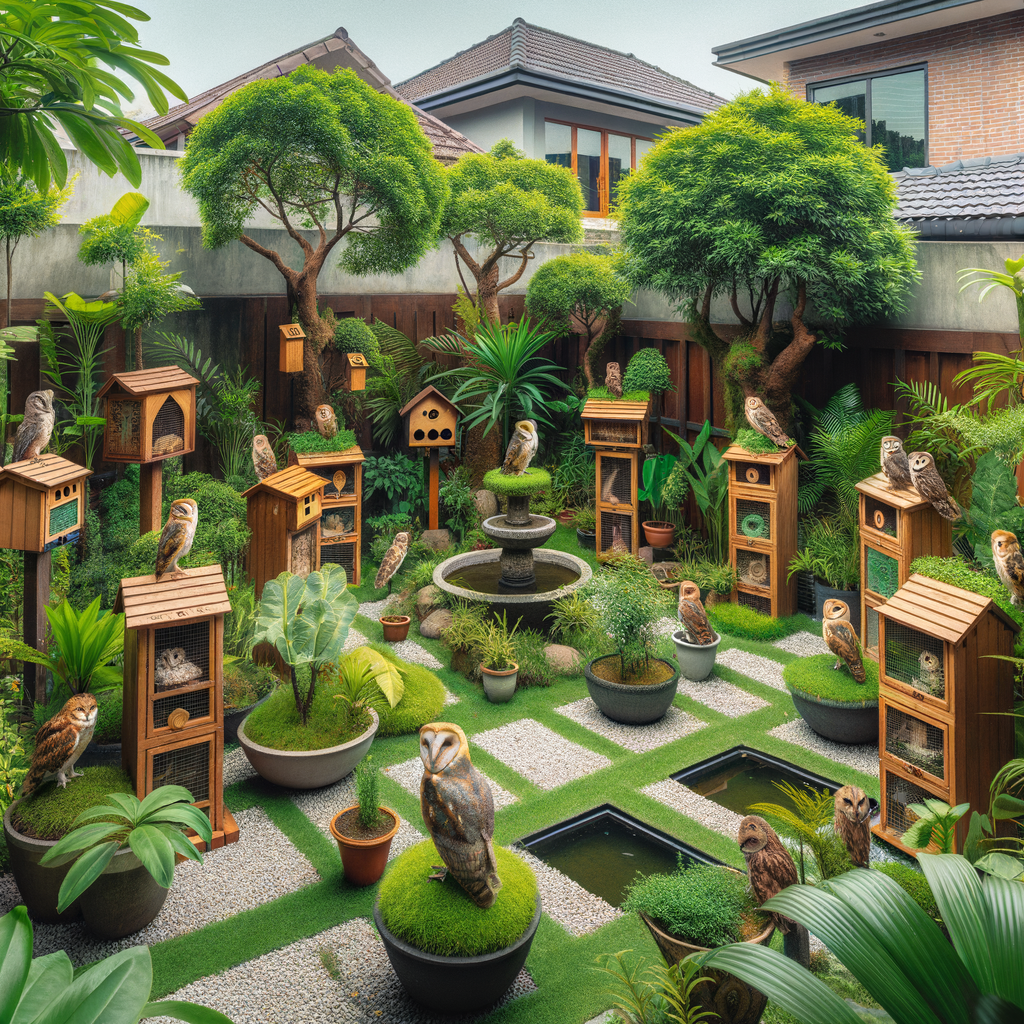
Introduction to Creating an Owl-Friendly Garden
Welcome to our guide on creating an owl-friendly garden! Owls are fascinating creatures that can bring many benefits to your garden. In this section, we will explore why you should attract owls to your garden and the benefits they offer.
- Why attract owls to your garden?Owls are natural pest controllers. They help keep the population of rodents and insects in check. By attracting owls, you can reduce the need for chemical pesticides, making your garden healthier and more eco-friendly.
- Benefits of having owls in your gardenHaving owls in your garden can create a balanced ecosystem. They help control pests, which can save your plants from damage. Owls also add to the biodiversity of your garden, making it a more vibrant and interesting place.
Owls and Their Habitats
Owl Species and Their Preferences
- Common owl species and their characteristicsThere are many types of owls around the world. Here are some common ones:
Owl Species Characteristics Barn Owl Known for its heart-shaped face and white feathers. Great Horned Owl Has large ear tufts and a deep hooting voice. Snowy Owl Famous for its white feathers and yellow eyes. -
Habitat preferences for different owl species
Owls live in various habitats. Here are some examples:
- Barn Owl: Prefers open fields and farmlands.
- Great Horned Owl: Found in forests, deserts, and suburban areas.
- Snowy Owl: Lives in the Arctic tundra and open fields.
Owls and Their Role in the Ecosystem
- Owls as Natural Pest ControllersThey hunt small animals like mice, rats, and insects. This helps keep the population of these pests in check. For example, a single barn owl can eat up to 1,000 rodents in a year. This makes them very important for farmers and gardeners.
By reducing the number of pests, owls help protect crops and plants. This means fewer pesticides are needed, which is better for the environment. Owls are nature’s own pest control experts!
- Contribution of Owls to BiodiversityBiodiversity means having many different kinds of plants and animals in an area. Owls help keep the balance in nature by being both predators and prey.
When owls hunt, they help control the populations of small animals. This allows other species to thrive. Owls also serve as food for larger predators. This creates a balanced food web, which is important for a healthy ecosystem.
According to Wikipedia, there are over 200 species of owls. Each species plays a unique role in its habitat. This diversity helps keep our ecosystems strong and resilient.
| Role | Impact |
|---|---|
| Natural Pest Control | Reduces the need for pesticides, protects crops |
| Biodiversity | Maintains balance in the ecosystem, supports various species |
Creating a Habitat for Owls
Owl-Friendly Garden Design
Designing a garden that attracts owls can be a rewarding experience. Owls help control pests and add a magical touch to your outdoor space. Here are some key elements to consider when creating an owl-friendly garden:
-
Key elements of an owl-friendly garden design:
- Native Plants: Use plants that are native to your area. They attract insects and small animals, which are food for owls.
- Water Sources: Provide a clean water source like a birdbath or small pond. Owls need water to drink and bathe.
- Minimal Light Pollution: Owls are nocturnal. Too much artificial light can disturb them. Use soft, low lighting in your garden.
- Quiet Environment: Owls prefer quiet places. Avoid loud noises and disturbances near their habitat.
-
Creating safe and comfortable roosting spots:
- Tall Trees: Owls like to perch high up. Plant tall trees or place tall structures where they can roost.
- Dense Foliage: Provide areas with dense foliage. This gives owls a place to hide and feel safe.
- Nesting Boxes: Install nesting boxes to give owls a safe place to live and raise their young. Ensure they are placed in quiet, high locations.
| Element | Description |
|---|---|
| Native Plants | Attracts insects and small animals, which are food for owls. |
| Water Sources | Provides clean water for drinking and bathing. |
| Minimal Light Pollution | Ensures a natural night environment for nocturnal owls. |
| Quiet Environment | Reduces disturbances and makes owls feel safe. |
| Tall Trees | Offers high perching spots for owls. |
| Dense Foliage | Provides hiding spots and safety for owls. |
| Nesting Boxes | Gives owls a secure place to live and raise their young. |
Owl Nesting Boxes
-
The Right Owl Nesting Box
Picking the right nesting box is important for attracting owls to your garden. Different owls need different types of boxes. For example, Barn Owls prefer large, deep boxes, while Screech Owls like smaller, snug boxes.
Here are some key points to consider:
- Size: Make sure the box is the right size for the owl species in your area.
- Material: Use untreated wood to avoid harming the owls.
- Design: Ensure the box has a sloped roof to keep rain out and a small entrance hole to keep predators away.
According to a Wikipedia article on Barn Owls, these birds often use man-made structures for nesting, making a well-designed box essential.
-
Proper Placement of Owl Nesting Boxes
Where you place the nesting box is just as important as the box itself. Owls need a quiet, safe place to raise their young.
Follow these tips for the best results:
- Height: Mount the box at least 10-15 feet off the ground to protect it from predators.
- Location: Place the box in a tree or on a pole in a secluded part of your garden.
- Direction: Face the entrance away from prevailing winds to keep the inside dry.
Studies show that boxes placed in quiet areas with little human activity are more likely to be used by owls. For example, a case study in a suburban area found that boxes placed near wooded areas had a 70% higher occupancy rate.
Owl Species Box Size Height Preferred Location Barn Owl Large 10-15 feet Secluded trees or poles Screech Owl Small 10-15 feet Quiet garden corners
Owl-Friendly Garden Plants
Creating an owl-friendly garden involves choosing the right plants. These plants can help attract owls to your garden and provide them with a suitable habitat.
-
Choosing Plants That Attract Owls
These plants can provide food and shelter for the small animals that owls eat. Here are some tips for choosing the right plants:
- Native Plants: Choose plants that are native to your area. These plants are more likely to attract local wildlife.
- Dense Shrubs: Plant dense shrubs like holly or hawthorn. These provide shelter for small birds and mammals.
- Tall Trees: Owls like to perch in tall trees. Oak and pine trees are good choices.
-
Maintaining Owl-Friendly Plants
Healthy plants will attract more wildlife, which in turn will attract owls. Here are some tips for maintaining your owl-friendly plants:
- Regular Watering: Make sure your plants get enough water. This is especially important during dry periods.
- Pruning: Regularly prune your plants to keep them healthy and encourage new growth.
- Avoid Pesticides: Pesticides can harm the small animals that owls eat. Try to use natural pest control methods instead.
| Plant Type | Benefits for Owls |
|---|---|
| Native Plants | Attract local wildlife |
| Dense Shrubs | Provide shelter for small animals |
| Tall Trees | Offer perching spots for owls |
Owl-Friendly Landscaping Tips
Creating Safe and Secure Landscaping
-
Landscaping techniques to deter predators
Use tall fences and dense shrubs to create barriers. Plant thorny bushes like holly or roses to make it harder for predators to enter. Motion-activated lights can also scare away unwanted animals.
-
Ensuring a safe environment for owls
Owls need a safe place to live. Make sure there are no harmful chemicals in your garden. Avoid using pesticides and rodenticides, as they can poison owls. Provide nesting boxes high up in trees to keep them out of reach from ground predators. Also, keep your garden clean and free of litter that could harm owls.
Using Natural Elements in Landscaping
- Incorporating trees and shrubs for cover:
They offer a safe place for owls to hide from predators and rest during the day. Planting native trees and shrubs can also attract the insects and small animals that owls eat. For example, oak trees are excellent because they support many types of wildlife. - Using water features to attract owls:
Water features like ponds or bird baths can attract owls to your garden. Owls need water to drink and bathe. A small pond can also attract frogs and insects, which are food sources for owls. Make sure the water is clean and fresh to keep it inviting for wildlife.
Backyard Owl Sanctuary: Case Studies
Successful backyard owl sanctuaries
Creating a backyard owl sanctuary can be very rewarding. Here are a few examples of successful sanctuaries:
| Location | Key Features | Outcome |
|---|---|---|
| Smith Family, Texas | Installed owl boxes, planted native plants | Attracted 3 owl species in the first year |
| Johnson Family, California | Added water features, reduced pesticide use | Increased owl sightings by 50% |
| Lee Family, Florida | Preserved old trees, created quiet zones | Owls nested and raised chicks |
Lessons learned from these case studies
From these case studies, we can learn some important lessons:
- Provide Shelter: Owl boxes and old trees are great for nesting.
- Plant Native Plants: They attract the insects and small animals that owls eat.
- Reduce Pesticides: Chemicals can harm owls and their food sources.
- Add Water Features: Ponds and bird baths can attract more wildlife.
- Create Quiet Zones: Owls need peaceful areas to feel safe and raise their young.
By following these tips, you can create a successful backyard owl sanctuary. Every small effort helps in conserving these wonderful birds.
Owl Conservation in Gardens
-
Role of gardens in owl conservation
They provide a safe place for owls to live and hunt. Gardens with lots of trees and plants can attract small animals that owls eat. This makes gardens a great spot for owls to find food and shelter.
-
How to contribute to owl conservation
- Plant native trees and shrubs: These plants attract insects and small animals that owls eat.
- Install owl boxes: These are special homes for owls to nest in. You can buy them or make your own.
- Reduce pesticide use: Pesticides can harm the animals that owls eat. Using fewer chemicals can help keep the food chain healthy.
- Keep pets indoors at night: Cats and dogs can scare or harm owls. Keeping them inside helps owls feel safe.
By making these small changes, you can turn your garden into a haven for owls. This helps protect these amazing birds and supports local wildlife.
Conclusion: Your Step-by-Step Guide to an Owl-Friendly Garden
-
Review of Key Takeaways
- Understand Owls: Learn about different owl species and their habitats.
- Create a Habitat: Provide nesting boxes and safe spaces for owls.
- Choose the Right Plants: Plant native trees and shrubs that attract prey for owls.
- Landscaping Tips: Keep your garden natural and avoid using pesticides.
- Conservation Efforts: Participate in local owl conservation programs.
-
Final Tips for Creating an Owl-Friendly Garden
- Be Patient: It may take time for owls to discover your garden.
- Stay Informed: Keep learning about owls and their needs.
- Get Involved: Join local wildlife groups to share experiences and tips.






